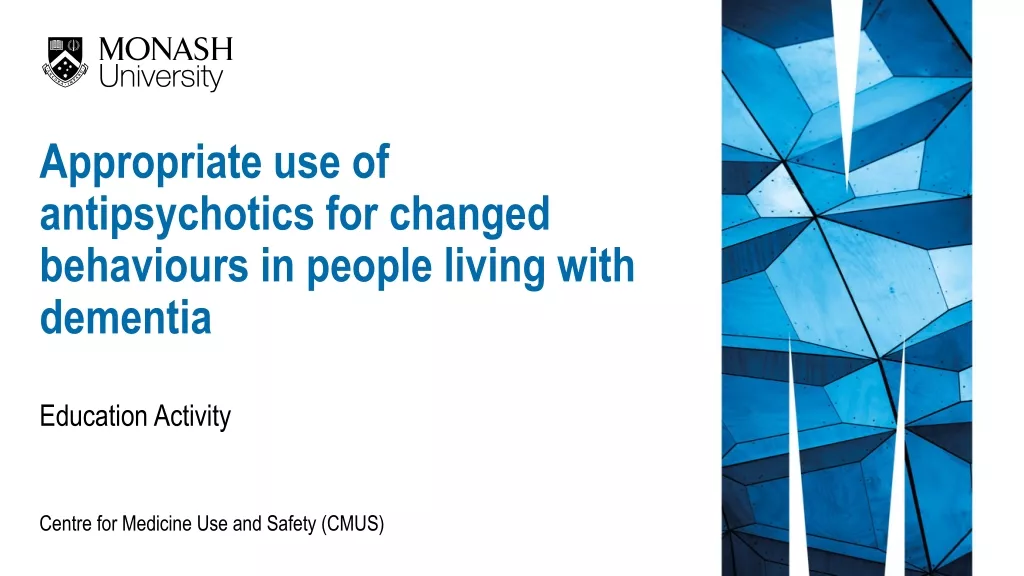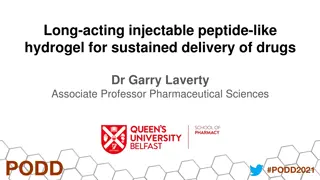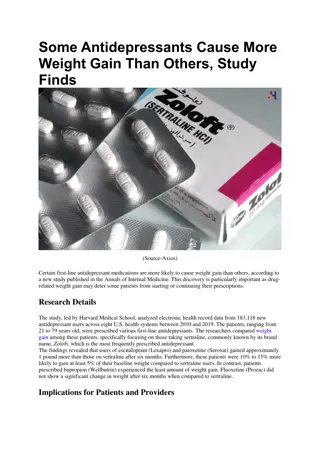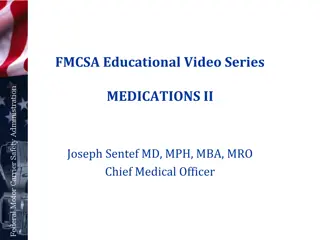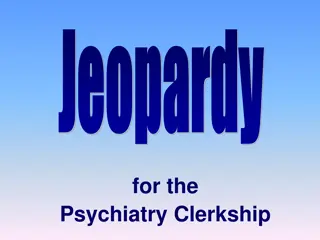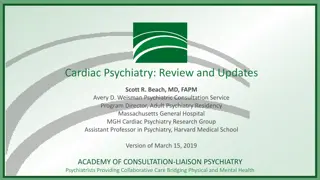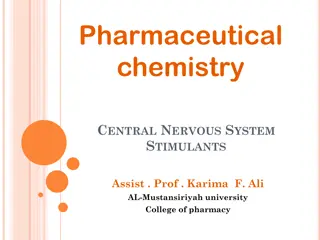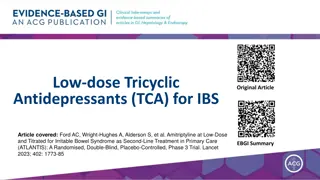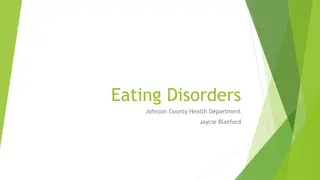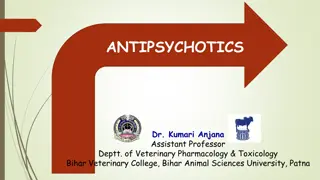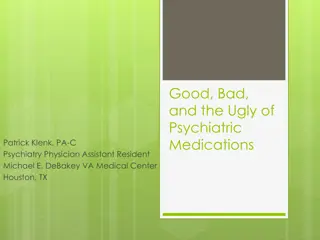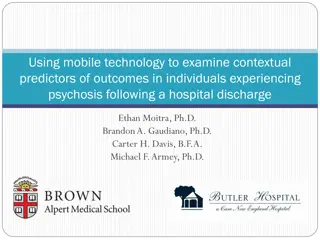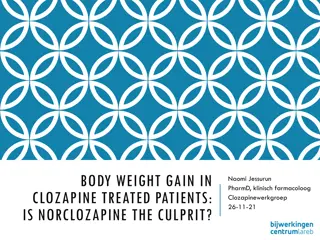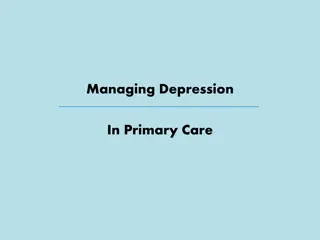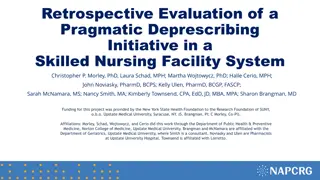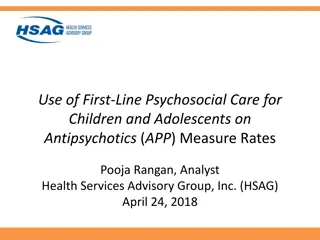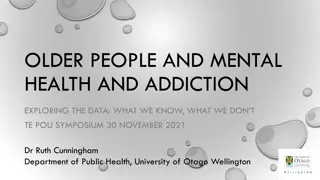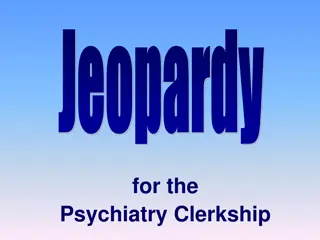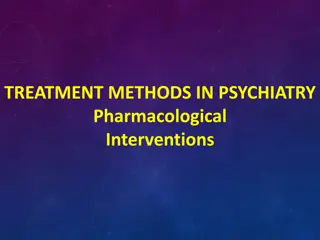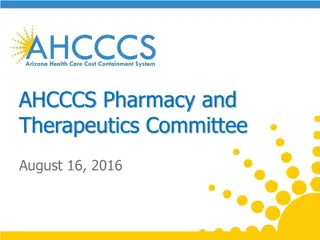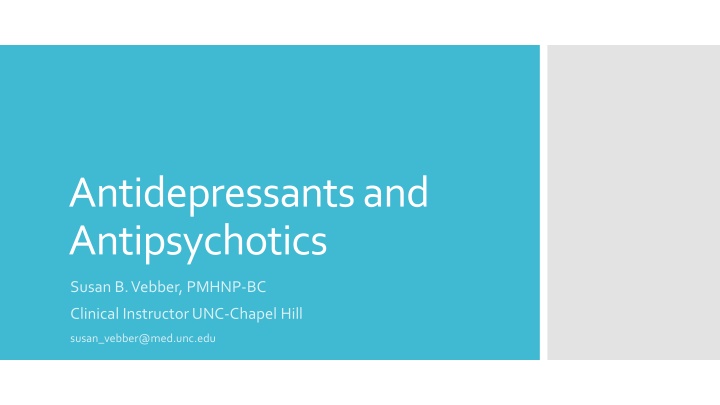
Mental Health Disorders and Treatment Options
Explore the impact of mental and substance use disorders on global morbidity, with insights into childhood exposure's links to adverse outcomes in adults. Learn about the prevalence of common mental illnesses, the shortage of child psychiatrists, and effective suicide prevention strategies like CBT and DBT.
Download Presentation

Please find below an Image/Link to download the presentation.
The content on the website is provided AS IS for your information and personal use only. It may not be sold, licensed, or shared on other websites without obtaining consent from the author. If you encounter any issues during the download, it is possible that the publisher has removed the file from their server.
You are allowed to download the files provided on this website for personal or commercial use, subject to the condition that they are used lawfully. All files are the property of their respective owners.
The content on the website is provided AS IS for your information and personal use only. It may not be sold, licensed, or shared on other websites without obtaining consent from the author.
E N D
Presentation Transcript
Antidepressants and Antipsychotics Susan B. Vebber, PMHNP-BC Clinical Instructor UNC-Chapel Hill susan_vebber@med.unc.edu
I have no financial endorsements and off label meds will be discussed
Mental and Substance use disorders account for 23% of global morbidity, more than any other group of medical disorders 50% of adults with a mental disorder reported onset by 14 years or younger Prevalence In terms of burden of illness, mental and substance use disorders are, in fact the predominant non-communicable disorders of young people 1 in 5 youth has a mental illness Insel, T. JAMA Editorial May 2014
In this study a childhood disorder had 6 times higher odds of at least 1 adverse adult outcome compared of those with no history of psychiatric problems and 9 times higher odds of 2 or more problems Untreated The best diagnostic predictor of adverse outcomes in adults was cumulative childhood exposure to psych disorders JAMA Psychiatry, PUblished online July 15, 2016
Less than 7,000 fully trained child and adolescent psychiatrists currently practicing in the US, despite estimates over 30,000 would be required to meet the demand. Needs The need for services is projected to increase 100% by 2020 Increasing importance for primary care provider in the management of mental health problems Center for Mental Health Studies
ADHD 6.8 Conduct disorder 3.5% Most prevalent mental health illnesses Anxiety 3.0% Depression 2.1% ASD 1.1% SUD (prior year) 4.7% Suicide was the second leading cause of death in youth CDC Major Report on Mental Illness in Youth
1999-2014 200% increase in suicide for girls age 10-14 Prevalence of suicidal behavior greater in depressed adolescents Only medication FDA approved reduce suicide is clozaril in schizophrenics Lithium has found to decrease suicidality in bipolar and depressed adults Suicide CBT and DBT are evidenced base therapies to reduce suicidality CDC https://www.cdc.gov/nchs/products/databriefs/db241.htm https://afsp.org/about-suicide/preventing-suicide/
FDA Black Box 2% placebo 4% SSRI (not statistically significant) Effexor Paxil Suicide &medications Rates during 3 months before and 6 months after initial antidepressant- one to two weeks after initiation is higher rate of suicidal ideation and possible activation Anti-depressant withdrawal, borderline personality traits, and psychosis higher risk at treatment w emergent suicidal behaviors simon et al (2006) Am J Psychiatry (163):41-47 Lawrence Hannah-Medication for Child Adolescent: 2017 39-53 MS Gordon and Levin , GA Do Antidepressants make children suicidal: 2014 vol 50 p847-854
Considered attempting suicide 15-16.3% in NC Made a plan 12-14% NC Attempted suicide 8.6% national Youth Risk Behavior Study Attempt with medical attention- 4-9% in NC Evidenced Base suicide questions- http://cssrs.columbia.edu/wp-content/uploads/Community-Ace- Card-2017-v2.pdf https://www.cdc.gov/healthyyouth/data/yrbs/-----Youth Risk Behavior Study
Structural changes Neurobiology of Adolescent Brain Cognitive Changes Neurotransmission Changes Neurodevelopmental Changes Cousins, Mendelay
Absence of FDA Approval does not equal prescription use Psychotropics for Youth On Label/Off Label Lack of approval means the drug was not adequately studied for the particular condition, at a particular dose or for a particular age group When used off label, risks, potential benefits and informed consent should be carefully documented. Diagnosis and Assessment in Pediatric Psychopharmacology Biederman, Joseph MGH 3/2016
Depressive disorders Anxiety disorders OCD (serotonergic) Antidepressant Use ADHD(noradrenergic, dopaminergic) Enuresis (TCA) Includes SSRI s, SNRI s, SDRI, TCA s, and SGAP s
Part of Treatment for mild to moderate symptoms Anxiety Exposure based CBT-8-12 weeks first then may add antidepressant Depression CBT concurrent with antidepressant Therapy/Meds DBT (cutters, impulsive in nature, possible borderline, sud) EMDR (trauma)-consistently outperforms CBT for trauma AACAO Guidelines Connolly & Bernstein, 2007
Comorbidity Adhd Depression 17-27% Anxiety 30% Ibs -50-90% Psychiatric Disorder Substance abuse- 2X as likely to suffer from mood disorder Death family at younger ages 2-3 fold chance of mood substance Comorbidities of prevalence Higher risk contracting depression again if have a history of it Brunsvold, G et al Psychiatric Times LOW ENERGY, DECREASED FOCUS ability and sleep cycle problem https://www.adaa.org/understanding-anxiety/related-illnesses/irritable-bowel-syndrome-ibs https://www.drugabuse.gov/sites/default/files/rrcomorbidity.pdf
Genes History- family history x3 Parental suicide attempt 5-fold increase for suicide attempt in offspring (independent of depression) Birth/perinatal Post partum depression increased risk History Environment- Social hx has moved changed schools bullying Parental job loss 2-3% increase risk in suicidal behaviors Developmental observations History of Concussion 3.3 fold increase risk for depression Brent DA et al. JAMA Psychiatry 2014 Dec 30 doi:10.1001/jamapsychiatry.2014.2141: Chrisman SPD & Richardson LP. J Adolescent Health 2014:54:582-586: Gassman-Pines A et al. Am J of Public Health 2014:104(10):1964-70
Thyroid Vitamin D EKG Labs HGB A1C LFT Cholesterol EKG s
Highest incidence of risk in adolescents Moderate to severe accounts for 1/3 of cases Only 60% respond Those that respond have 60-70% reoccurrence What does it look like in children and adolescents Untreated increases risk suicide, anxiety disorder, SU, and physical health problems Low mood, decreased motivation, sadness, isolation, withdrawal, irritability, and anhedonia, anger Cousins et al, Antidepressants and the Adolescent Brain, Journal of Psychopharmacology Vol 29: 545-555
Fluoxetine 8-17 FDA Approval/vs Pediatric Trials for MDD Escitalopram 12-17 Other Controlled Pediatric Depression Trials - Sertraline, Citalopram positive - Paroxetine, Mirtazapine, Nefazodone, Venlafaxine no change Prozac Prescribing information, Lexapro Prescribing information:
Anhedonia was the depressive symptom most associated with poorer recovery in TORDIA (led multiple trials) Irritability, more severe outcomes Greater illness severity Higher suicidality Greater episode duration Greater number of MDD Anhedonia Gabbay V et al. J Child Adol Psychopharm, 2015, 25,1940200 McMakin DL et al. J Am Acad Child and Adolesc Psychiatry 201:51:404-411 https://www.ncbi.nlm.nih.gov/pubmed/20478877
TREATMENT RESISITANT DEPRESSION ALGORITHM SSRI/Fluoxetine/escitalopram If no response maximum dose minimum 8 weeks Alternate SSRI Treatment Resistant Depression Algorithm Fluoxetine/escitalopram/sertraline If partial response augment Aripiprazole, lithium or bupropion If no response maximum dose minimum 8 weeks Different Class of Antidepressant Bupropion/venlafaxine/duloxetine/desvenlafaxine If no response maximum dose minimum 8 weeks If partial response augment Aripiprazole or lithium Newer Antidepressant Vilazadone/levominacipran/vortioxetine Wagner, D: MGH Psychiatry Academy Juvenile Depression March 2016
US National Comorbidity Survey: Anxiety disorders are the most prevalent class 12 Month Prevalence in Children 3.7%-8.9% Anxiety Disorders (Costello, 1988, 1996; Ford, 2003) 6 Month Prevalence in Adolescents 8.7%-17% (Kashani & Orvaschel, 1988) Lifetime Prevalence in Adults 15%-25% (ECA& National Comorbidity Study) Keseler t al, Arch Gen Psych, 2005; Pagura et al, J Ner Men Dis 2008)
Genetic risk 2-3 fold increase in risk Exposure to maternal anxiety disorder predicts childhood anxiety disorders Anxiety Exposure based CBT most empirical support- informed consent psychotherapy is not informed without discussion of CBT MGH Gellar, R AACAP guidelines, Connolly and Bernstein 2007: Albano and Kendall 2002
Excessive interpersonal sensitivity Fear Anxiety- what does it look like Apprehension Exaggerated responses Explosive outbursts Somatic Complaints Strawn, Jeffrey Efficacy and Tolerability of Antidepressants in Pediatric Anxiety Disorder :Depression and Anxiety, 3/2015
TABLE 1 Dosing Guidelines Drug Starting Dose (mg) Typical Dose Range (mg) (Mean Dose) Preadolescent- Adolescent CHILD Adolescent Dosing Guidelines AACAP Clomipramine, 6.25 25 50 200 Fluoxetine 2.5 10 10 20 10 60 Sertraline 12.5 25 25, 50 200 Fluvoxamine 12.5 25 50 300 Paroxetine .2.5 10 60 Citalopram 2.5 10 10 60 J. AM. ACAD. CHILD ADOLESC. PSYCHIATRY, 46:2, FEBRUARY 2007
*First Line- SSRIs, Venlafaxine, Duloxetine *Second Line- buspirone, benzo s, TCA s *Third Line-Mirtazapine, gaba-adrenergic anticonvulsant, propranolol,alpha agonists *Fourth Line-Low Dose Atypical, quetiapine Guide for Pediatric Anxiety Disorders ALL are off label as there are no FDA Approved Medications for Anxiety in Children Fluvox and Fluoxetine for OCD * Denotes off label MGH Talk: Gellar Pharmacology of Anxiety and OCD in Childhood and Adolescence
First Line: SSRI- Fluvox (1-3 weeks) Fluoxetine (4 weeks) Second Line: Alternative SSRI or clomipramine OCD Treatment Guidelines What is tx resistant? SSRI + Benzo (clonazepam) Leonard et al 1994 SSRI + SGA Bloch 2006 Abilify low 2 mg and Risp as low as 0.5 (esp if poor insight-educate on arousal and helpful with tic related ocd) Masi, G, Pfanner, C, Brovedani, P Journal Psychiatric research 2013 Experimental DBS Flavio Guzman
Bupropion NDRI Clomipramine-TCA Atypical Antidepressants Imipramine-TCA- Mirtazapine-TCA Trazodone-SARI
Brintillex- Study age 7-17 recruiting- cognitive enhancer adults Vybrid- Age 11-17 study completed Oct 2016 no update yet-adults anxious depression Update Newer Antidepressants Fetzima-recruiting 12-17- SNRI for MDD and fibromyalgia in adults- recruiting at this time CDC Major
Antidepressant V Half Life in Days Citalopram/escitaolopram 1.5 Paroxetine 1 Sertraline 1,1-1.3 Fluoxetine 4-16 Fluvoxamine 0.6 Switching AD s Desvenlafaxine 0.4 Duloxetine 0.5 Venlafaxine 0.6 Imipramine 0.2-1.3 doi: 10.18773/austprescr.2016.039
Chronic Pain Duloxetine and TCAs Asthma-Amitriptyline (depression/sleep) Doxepin (bronchodilator effect) Treatment of comorbid medical complaints Ibs/Crohns-(off label) SNRI dep/pain- however TCA low dose anxiety-Mirtazapine if anorexic type behaviors Sleep disorders- melatonin, trazodone, antihistamines- decrease response tx Substance abuse-treat underlying issue Zielinski, T Prim Care Companion J Clin Psychiatry. 2000 Oct; 2(5): 153 158. Szigethy, E , MD https://www.youtube.com/watch?v=5_0YJQtb6eo Conroy DA, Huntley ED (2013) Treatment for Insomnia in Depressed Adolescents. J Sleep Disord Ther 2:132. doi:10.4172/2167-0277.1000132
Atypicals Psychotic disorders Antipsychotic Use Tourettes disorder Bipolar disorder Dysphoric control Augmentation of antidepressants
% of use in US? Race? Prevalence Disease? FDA approval Cataife, G et al Racial an dEthnic Differences in Antipsychotic Med use among children enrolled in Medicaid Psychiatric Services 66:9, September 2015
Receptors 2nd Generation Antipsychotic Neurobiology Half Life Overall response http://effectivehealthcare.ahrq.gov/index.cfm/search-for-guides-reviews-and- reports/?productid=2149&pageaction=displayproduct
Meds Ages Indication s FDA Dosing Avg. wt. gain Half Life Hours Aripiprazole dose 50% using another CYP2D6 6-17 13-17 schizo 10-17 manic/mixed 6-17 irritability autistic 6-18 Tourettes 2-300mg 2-30mg 4.4 kg 75-146 15 mg day max 20 mg day Risperdal- concerns gynocomastia 5-17 13-17 schizo 10-17 Bipolar manic 5-17 irritability autistic 6-17 Tourette 1-6 0.5-6 5.3 kg 20-30 Common SGA s 0.5-3 0.5-3 Quitapine (IR and ER) 13-17 schizoph 10-17 bipolar manic Schizophrenia and bipolar mania 400-800 schiz 400-600 mania 6.1 kg 6 Olanzapine- prolactin increase 13-17 schiz/bipolar mixed manic 10-17 bip dep Bipolar dep/mixed/ma nic and schizophrenia 2.5-20 8.5 kg 20-27 Saphris 10-17 Bipolar Mixed/Man 2.5-10 mg BID 24 Invega 12-17 Schizophrenia 3-12 mg 23 FDA
Meds Ages Indications Dosing Latuda Approved Adults Bipolar Depression 40-160 mg Vraylar Approved Adults Schizophrenia Bipolar Manic/Mixed 1.5-6 mg Newer SGA s- no FDA Label for children/adoles cents Rexulti Approved Adults Bipolar 2-4mg Invega Sustenna Approved Adults Schizophrenia/Sc hizoaffective 39-234 mg IM FDA prescribing information
Baseline BMI Fasting glucose, lipids, BP Family hx of obesity, DM,CVD,HTN BMI check 4,8,12 weeks and 3 months afterwards Fasting glucose, lipids, BP Check 3 months then annually if abnormal Intervene for abnormalities Metformin Behavioral weight loss interventions LFT s Metabolic Follow UP AACAP Guidelines Metabolic Monitoring
Omega 3s- study pre-pubertal depression 1000mg -70% response Study prodromal schizophrenia response Vitamin D-case series improved well-being Mixed reviews on light therapy Supplements Exercise prescription can be useful Beware of St John s Wort- serotonin agent DHA Nemets, H et al AmJ Psychiatry, 2006:163(6): 1098-1100
NAMI Sparx- CBT game online-you tube channel as well www.ascap.org www.parentsmed.org Resources for kids/family Mood Apps Videos Suicide hotline LME Crisis Line CDC Major
Neuropsychologist vs psychologist- brain injury (drugs) Hospital Resources for providers Suicide evaluation GLAD-PC

